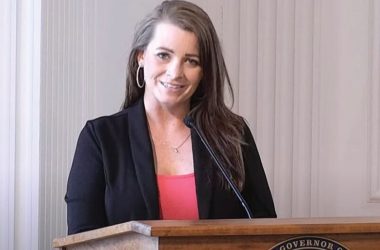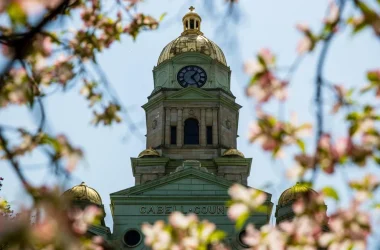CHARLESTON, W.Va. — West Virginia’s four-year graduation rate from public high schools last school year was about 90 percent, state Superintendent Michael Martirano announced Tuesday.
That 2015-16 rate, 89.8 percent, is up from 86.5 percent for the 2014-15 school year, when West Virginia ranked 18th out of the 50 states, and 84.5 percent for 2013-14, when it ranked 25th.
“This metric point, this number, is so significant, because it represents real children graduating,” Martirano said at an event at Charleston’s George Washington High School, which had a roughly 96 percent graduation rate. “If children drop out of high school, they are destined for challenges: higher level of drug use and abuse, higher levels of concern, in terms of juvenile delinquency, greater concerns in terms of the incarceration rate.”
But West Virginia’s increasingly rosy graduation rate clashes with some national and state measures of the quality of the state’s education. Rising graduation rates are a national trend.
The White House announced just last week that the nationwide public high school graduation rate for 2014-15 was 83.2 percent, a record high, and the federal government hasn’t yet released the nationwide rate or a list of other states’ rates for 2015-16. If West Virginia had an 89.8 percent rate in 2014-15, it would have ranked No. 2 in the country, behind only Iowa’s 90.8 percent.
West Virginia’s rate was around 78 percent for the 2010-11 school year. According to last week’s White House news release, 2010-11 was “the first year all states used a consistent, four-year adjusted measure of high school completion.”
That measure is the adjusted cohort graduation rate, which, according to the U.S. Education Department’s National Center for Education Statistics, is the number of first-time ninth-graders who earn a regular high school diploma within four years. The rate includes students who transfer in after ninth grade, and excludes students who transfer out, emigrate to another country or die.
State Department of Education officials said Tuesday that county- and school-level graduation rate data should be released by at least Nov. 10.
Martirano said that, of the state’s roughly 118 public high schools, 70 reached a 90 percent graduation rate or higher last year, up from only 47 that hit that mark in 2014-15.
“It’s how we respond when children are failing. So when a young person in ninth grade starts falling behind in credits, how do we respond to ensure that they have credit recovery, that we’re able to make certain that they’re moving forward so they don’t get so far behind,” Martirano said. “We’ve really shifted the norm and the paradigm about how we do business. Every child matters.”
The nationwide public high school graduation rate is up from 79 percent in 2010-11. In the national news media, there’s been discussion about how difficult it is to pinpoint why graduation rates are rising, and debate over whether the rising proportion of seniors graduating really means more students are prepared for colleges and careers.
West Virginia’s average scores on the 2015 National Assessment of Educational Progress were considered significantly — using the statistical definition of significant — lower than 34 states in fourth-grade reading, 32 states in eighth-grade reading (although it was the only state to see a significant increase in eighth-grade reading over 2013), 34 states in fourth-grade math and 43 states in eighth-grade math.
The NAEP, the biggest nationally representative assessment of the nation’s students, is given to a sample of students in those grades every two years.
The 2015 NAEP test for 12th-graders reported results only on a national basis. Students didn’t score significantly different in math than they did in 2005, when the new version of that part of the test took effect.
West Virginia’s high school math proficiency rates for last year on the Smarter Balanced test, the standardized exam that public school students take each spring, were 20 percent for ninth-graders, 19 percent for 10th-graders, and 21 percent for 11th-graders. Those were improvements over the previous year.
High school seniors don’t take the Smarter Balanced test.
The 2014-15 math proficiency rate for 11th graders — those students who were supposed to be graduating at the end of last school year — was only 20 percent. Smarter Balanced, which debuted statewide in 2014-15, doesn’t count toward graduation.
Martirano said West Virginia has not been lowering academic standards to graduate more children.
“I don’t want this to be a diploma mill, in that sense, where we’re just making sure that children are just socially promoted,” he said. “We’ve eliminated all of those things. We have the highest number of credits, in terms of expectations, we have 24 credits that our young people have to finish to graduate, we have very high attendance standards that they have to graduate.”
He said he’s been encouraging credit recovery in schools via the use of technology and encouraging keeping students on track to graduate early on. He said his department has an accreditation process to ensure the quality of credit recovery.
Asked why he thinks the statewide graduation rate is increasing, Martirano said he has made it a “major focal point” and “primary goal” during his two-year tenure, and noted the focus on attendance and other issues.
“It’s all of those things, working together,” Martirano said. “This is not something we left to chance.”
The announcement was made in George Washington’s gymnasium before an assembly of the full student body, which Principal George Aulenbacher said contains about 1,078 students.
Aulenbacher touted the fact that his school’s 2015-16 rate was 95.9 percent, up from 91 percent in 2014-15 and 75 percent in 2008-09.
Missy Ruddle, Kanawha County’s assistant superintendent for curriculum and instruction, is a former principal at G.W. whom Aulenbacher credits for helping raise the rate. She said G.W. had the highest public high school graduation rate in the county last year. Martirano said he thinks there were a few schools, with small graduating classes, that reached 100 percent.
Aulenbacher credited countywide efforts to raise graduation rates, including focusing on individual students and their course needs, instead of just focusing on a group.
Reach Ryan Quinn at [email protected], facebook.com/ryanedwinquinn, 304-348-1254 or follow @RyanEQuinn on Twitter.



